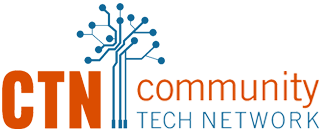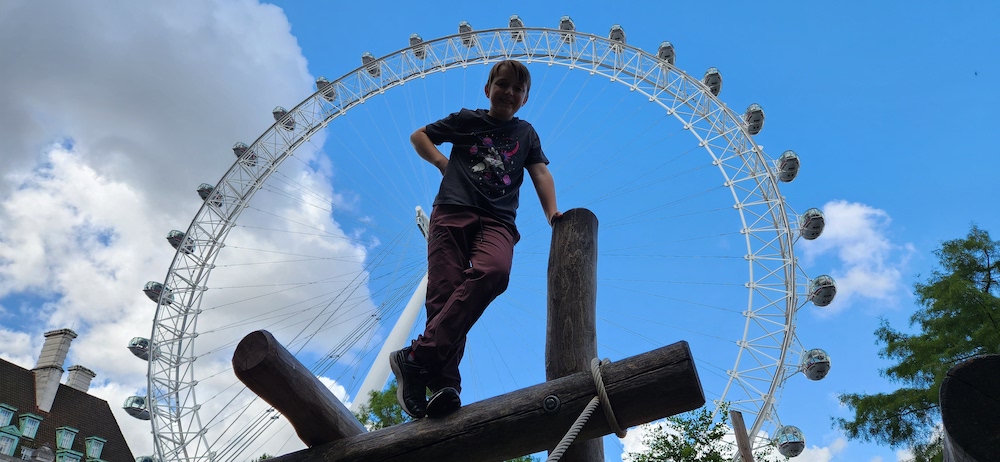This blog post was written by Kami Griffiths, Community Tech Network’s Co-Founder and Executive Director, after returning from a three-month sabbatical from July to October 2023. Pictured above: her son at the London Eye during their trip to England.
The idea of taking a sabbatical is a dream that many of us have. In some environments, like academia, there is an expectation that, after a specific duration, you will take an extended period of paid time off to pursue a meaningful endeavor.
I first started dreaming about a sabbatical in 2015 when I applied to the O2 Initiatives, a program specifically designed to offer sabbaticals for nonprofit leaders in California. I wasn’t selected but always kept the dream alive that one day I would have the opportunity to take a much-needed break.
That opportunity arose in 2022 after I took two weeks off for an international vacation. I completely unplugged, and upon my return, a coworker exclaimed “You should go on vacation more often, it forced me to do work that has been on my plate for a while!”
Because I have been with CTN since the beginning, I have performed nearly all the different jobs that needed to be done. As we grew and I was able to hire more staff, I handed off those many hats to different people, but I didn’t always relinquish all the tasks associated with each job. My reasons were varied, but ultimately this bad habit didn’t serve me or the organization.
The above statement from my coworker reignited my interest in a sabbatical, and I immediately started my research. I floated the idea to a few coworkers to gauge their response and one of them said “I haven’t had enough coffee yet to have this conversation.” I didn’t let this deter me.
I discussed the idea with my board chair, who was very supportive and put it on the agenda for the next board meeting. The board had concerns: Did we have the right staff doing the right work that would allow me to leave? What would I accomplish while I was out? Would it need to be something that would benefit CTN, like what is expected of university professors, and would I need to set specific goals and hold myself accountable to achieving them?
Since no one from CTN had ever taken a sabbatical, we needed a policy that could be applied to everyone after me. I used templates provided by the Durfee Foundation.
We analyzed our staffing needs and determined that all aspects of my job would be covered by existing employees except for fundraising. To account for this, we hired a full-time Fund Development Manager who started just two weeks before I was set to leave.
I created a plan documenting tasks to happen before, during, and after the sabbatical and I presented a draft to the board two months before my leave. I also worked with the leadership team to ensure that they understood what they had the power to decide and what needed to be escalated to the board.
During the three months away, I was able to take a trip to England with my son and stay with a good friend. I jumped at opportunities to spend time with friends and be more spontaneous. I tackled some projects around the house that had been largely ignored for years. I created some good habits of meditating daily and exercising regularly. I spent hours in the pottery studio throwing and glazing mugs, pots, and vases. I felt like a person first and not an extension of my laptop, and I wasn’t constantly checking my calendar for fear of missing a meeting.
Here are my biggest takeaways that I strive to remember and share with my staff:
- Create and maintain good boundaries: It’s easy to start the day by reading and responding to emails or getting back on the computer after dinner to work on unfinished tasks, but this takes time away from friends, family, and most importantly, you.
- Avoid the hamster wheel: I compare the constant cycle of checking my email to that of a hamster wheel. I check my email to see if there’s anything urgent to address, go back to working on a project, get stuck, go back to check my email, repeat. Each time I jump over to email, I lose track of where I am in the project, and it takes time to get started again.
- Don’t pack your calendar: I often joke that I can’t get any work done since I’m always in meetings. Of course, meetings are part of our jobs, but so too are the things we agreed to do in the meetings. Allocating time between meetings or setting aside dedicated time each day to catch up on tasks will help ensure that you don’t have a pile of unfinished work remaining at the end of the day.
- Don’t forget to breathe: It is a well-known fact that meditation can clear your mind and help you become more focused. It’s easy to get caught up in the frenzy of deadlines and drama, but don’t let those activities trigger the return of bad behavior or thought patterns.
I’m proud that I’ve built an organization that is staffed with the right people in the right positions to allow me to take this well-needed break. With the massive amount of state and federal funding coming to support digital equity, I know the next five or six years are going to be intense, and I feel ready to take on the exciting challenges ahead. I am fortunate to have a job that allows me to interact with such kind people and to do work that has a positive impact on the world.
In 2030, I’ll be eligible for my next sabbatical, and I’m already dreaming about what I might want to accomplish then.


Comments are closed.